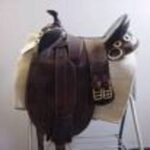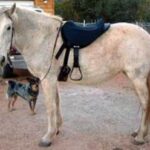You’ve probably seen the professional reiners and cutters riding their horses in the arena. They sit down in the saddle and utter a simple “Whoa”, which is followed immediately by a perfectly square halt. Teaching your horse “Whoa” isn’t difficult, but it does require patience if your want your horse to stop on a dime.
In some sports, such as dressage, it is not appropriate to tell your horse “Whoa” because verbal cues are not allowed. In other sports, such as reining, verbal indicators are welcome, if not expected. You don’t have to use the word “Whoa” in order to stop your horse on a dime, but it does help during the learning process because it’s a clear statement of what you want. Even if your physical cue isn’t perfectly consistent, your horse still hears the word and knows what you want.
Teaching your horse “Whoa” requires an understanding of how your horse stops. A correct halt starts on the forehand (the front two legs), followed by the planting of the hindquarters. This ensures that your horse is “in front of you” and using his back end and top line correctly. If your horse stops with his back legs first, he is likely to fall on the forehand. This is true across the board for equestrian sports, and even more so for reining and cutting because your horse is expected to slide on a stop.
When you ask your horse to “Whoa”, it shouldn’t need to be accompanied by a sharp tug on the reins. Your hands aren’t what stops your horse; instead, your seat, legs and voice should clearly communicate what you want. Sitting deeply in the saddle, lifting your reins slightly and closing your knees should be sufficient, but this does require a bit of training to succeed.
In order for your horse to stop on a dime correctly, he first requires the muscle development to accomplish this feat. Such stops require the use of the haunches, top line and leg muscles, particularly if your want your horse square on the stop (all four feet evenly placed). Many horse trainers accomplish this goal by first teaching their horse to back up correctly, which uses the same muscles.
I’ve met a few horse trainers who go one step further with this philosophy and use backing up as punishment for a sloppy stop. When the horse fails to stop on a dime, the rider forces the horse backward several steps, then starts the process over. I see a few problems with this training method, not the least of which being that you don’t want your horse to fear backing up. It’s a tool, not a punishment system.
When you start teaching your horse “Whoa”, make sure that your cues are correct. Sit deeply in the saddle, shove your heels down, close your knees, and lift the reins. Say “Whoa!” in a commanding voice. If your horse doesn’t respond, take up more rein and ask again. When he stops, back your horse up three or four steps, then pat his neck and send him forward as a reward.
If you find that your horse is stopping on a dime, but planting his back feet first, you must do the opposite of what seems logical. Ask for the halt, then give him leg with the inside of your calf. This sends him forward into the stop, forcing his hind legs to follow the front. At first, he might throw his head up during the stop, but this should change as soon as he’s developed sufficient muscle.







